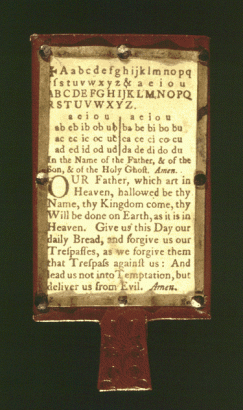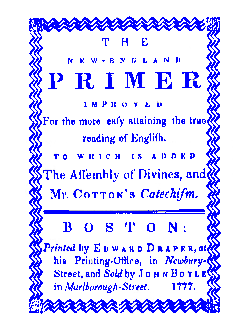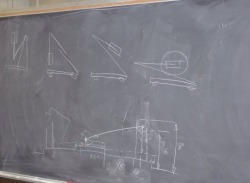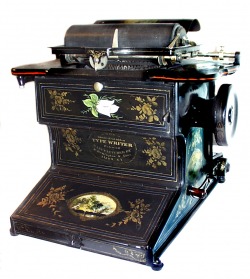Hornbook 1600s

The hornbook was used by school children for several centuries, starting in the Mid-15th century, in Europe and America. The hornbook consisted of a wooden paddle with lessons tacked on and covered by a piece of transparent horn. The wooden paddle was approximately 2 3/4" x 5" with an easy to hold handle. A hole was put in the handle so a leather thong could be tied to it and the child could carry it on his/her belt or around his/her neck. The lessons consisted of different combinations of the following things: the alphabet, vowel and consonant combinations, the Lord's Prayer, a form of a cross, and a praise of the Trinity. These were hand written on a piece of parchment, then tacked to the wooden paddle. The horn tacked on over the lessons was used to keep the lessons from being soiled by the child. The horn of oxen and sheep were used to make the laminating structure. The horn was left in cold water for several weeks, which separated the usable part from the bone. It was then heated, first in boiling water then by fire, and pressed by plates and machines to make it smooth and transparent. As time went on, hornbooks were also made of a variety of other materials. They were made from ivory.
History of Hornbook
New England Primer 1600s

The New England Primer, was by far the most commonly used textbook in the United Stated for over 100 years. The first edition was printing in 1690 and it was still in used in 1900. It was used in public and private schools. It was intended to be used to help teach children to read: it included a rhyme to teach the alphabet, vocabulary words, and many short poems and other practice reading selections. While the idea of having separate grade levels was not introduced until the 1800’s, this book was used for what would today be considered first grade. It also included some religions reference.
The New England Primer was a textbook used by students in New England and in other English settlements in North America. It was first printed in Boston in 1690 by Benjamin Harris who had published a similar volume in London. It was used by students into the 19th century. Over five million copies of the book were sold.
In the 1700's schools in the colonies were strongly influenced by religion. It was the intent of the colonists that all children should learn to read and in 1642 Puritan Massachusetts passed a law stating this. They believed that an inability to read was Satan's attempt to keep people from the Scriptures.
The New England Primer followed a tradition of combining the study of the alphabet with Bible reading. It introduced each alphabet letter in a religious phrase and then illustrated the phrase with a woodcut. The primer also contained a catechism of religious questions and answers. Emphasis was placed on fear of sin, God's punishment and the fact that all people would have to face death.
Here are some examples of alphabet rhymes that teach moral values as well as reading.
A In Adam's Fall
We sinned all.
B Thy Life to Mend
This Book Attend.
C The Cat doth play
And after slay.
D A Dog will bite
A Thief at night.
E An Eagle's flight
Is Out of sight.
F The Idle Fool
Is Whipt at School.
Also, first appearing in the New England Primer was the Children's Prayer beginning "Now I lay me down to sleep..."
Slates 1700s
In early schools, each child owned a book-sized writing slate encased in a wood frame. This was used for practicing script and it traveled to and from school with the student each day. The student scratched the slate with a slate pencil, which was a cylinder of rock. Eventually, the slate pencil was replaced by soft chalk, making it easier to write. Students did not preserve any of their work in the form of what is described today as class notes. Memorization, therefore, was emphasized and achieved through collective recitation led by the teacher. A keen memory characterized a good student.
Before 1800, instructions at both the elementary and secondary levels was predominantly individual. The principal method of the village schoolmaster consisted of calling one or several pupils to his desks to hear individual, memorized recitations. Developing understanding trough inductive group discussions was unknown.
Chalkboard 1800s

The first blackboard used in a school was in Philadelphia in 1809. Early blackboards were made from pine lumber and covered with a mixture of egg white and carbon from charred potatoes. Teachers and students wrote with chunks of chalk and erased with cloth rags. These blackboards and slate boards were laborious apparatuses, and the accompanying chalk dust was the bane of all teachers.
Fountain Pen and Paper 1800s
The first blackboard used in a school was in Philadelphia in 1809. Early blackboards were made from pine lumber and covered with a mixture of egg white and carbon from charred potatoes. Teachers and students wrote with chunks of chalk and erased with cloth rags. These blackboards and slate boards were laborious apparatuses, and the accompanying chalk dust was the bane of all teachers.
Pennmanship was an important skill — it was commonly believed that the appearance of one’s script was more important than its accuracy. The quill pen was used for important writing tasks or for written work that would be exhibited. It was the teacher’s job to whittle goose quills and make ink for the inkwells. In cities, the ink was made of ink powder mixed with water. In the country, the ink was made of lampblack or tannic acid from oak tree galls mixed with light oil or from swamp maple bark and copperas. Writing with ink could be messy, so students used blotting paper to absorb excess ink from the page when they were finished.
By the 1870s mass-produced paper was inexpensive enough to be used in the classroom, bringing with it the opportunity to take work from school home to share with parents. Also, students could write and keep longer pieces including stories, journals, and other sentimental or self-expressive writing.
Lead Pencil 1800s
After the Civil War, manufactured lead pencils similar to those used today were introduced. This also meant that most student work was now written on paper, making the work more portable for both teacher and student. Students owned pencil boxes for the safe transport of these pencils. The pencil was a substantial improvement. Its narrow design made it easier for children — especially young children with small hands — to control their writing and develop lettering and numbering skills.
Typewriter 1800s

It was called the "Sholes & Glidden Type Writer," and it was produced by the gunmakers E. Remington & Sons in Ilion, NY from 1874-1878. It was not a great success (not more than 5,000 were sold), but it founded a worldwide industry, and it brought mechanization to dreary, time-consuming office work.
The idea began at Kleinsteuber's Machine Shop in Milwaukee, Wisconsin in the year 1868. A local publisher-politician-philosopher named Christopher Latham Sholes spent hours at Kleinstuber's with fellow tinkerers, eager to participate in the Age of Invention to produce devices to improve the lot of Mankind.
It's said Sholes was working on a machine to automatically number the pages in books, when one of his colleagues suggested the idea might be extended to a device to print the entire alphabet. An article from "Scientific American" was passed around, and the gentlemen nodded in agreement that "typewriting" (the phrase coined in SA) was the wave of the future.
Sholes thought of a simple device with a piece of printer's type mounted on a little rod, mounted to strike upward to a flat plate which would hold a piece of carbon paper sandwiched with a piece of stationery. The percussive strike of the type should produce an impression on the paper.
